Want Us To Contact You?
The Mormon Battalion Trail Auto Tour
The Mormon Battalion Trail makes for an inspiring road trip vacation!
Click on the states below to see great places to visit who have sponsored The 175th Anniversary Mormon Battalion Trail program:

Download the FREE
Mormon Battalion Trail Mobile Tour
Click on the icons below to download the FREE
Map-N-Tour app from the app store.



Click here to explore the Desktop version of the Tour.
IOWA/NEBRASKA
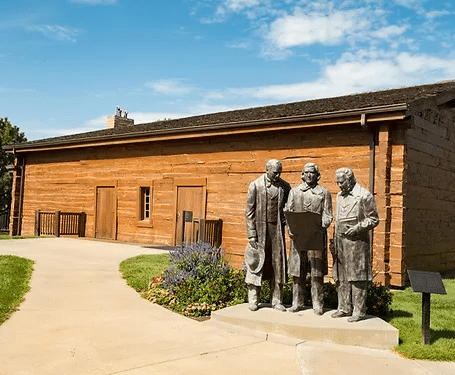
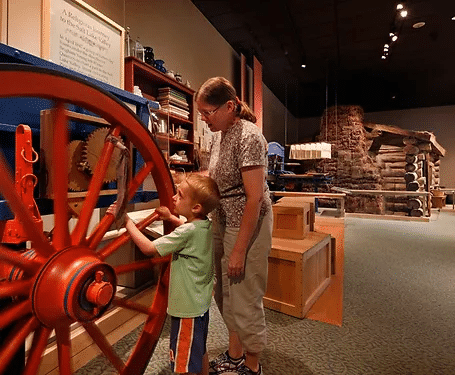
Council Bluffs
Council Bluffs is convenient to I-80 and I-29. Brigham Young and the advance group of Church of Jesus Christ of Latter-day Saints arrived in Council Bluffs on June 13, 1846. They camped at Mosquito Creek Hill, later called Redemption or Taylor Hill which today is adjacent to I-29 at East 29th Avenue and Harry Langdon Boulevard. To see the early Mormon Pioneer Trail historic sites in the area, go to this website.
The sites of the 1846 Grand Encampment of Mormon Pioneers and the Mormon Battalion Mustering Grounds are today on the grounds of the Iowa School for the Deaf, east of I-29 at the intersection of US 92 and Harry Langdon Boulevard. Two historical markers and a walking path at the area are located on the scenic grounds where visitors can still imagine the enlistment and mustering of Battalion volunteers on July 16, 1846 for one year. They marched for Fort Leavenworth on July 21st.
The reconstructed Kanesville Tabernacle and visitor center is a few hundred yards from the actual location of the reorganization of the First Presidency of the Church of Jesus Christ of Latter-day Saints in 1847. The Tabernacle is not open for public tours, but a visitor center has exhibits and a film on the Mormon Battalion’s journey and its achievements. Go to this website.
Omaha is across the Missouri River, accessible by either I-480 or I-80. The Mormon Trail Center at Winter Quarters is in north Omaha at 3215 State Street. The Center features interactive exhibits, artwork, reconstructed settings, artifacts and a film on the Mormon Trail pioneers, the Mormon Battalion, and the historic Winter Quarters of 1846-48. Go to this website.
Nebraska City and Otoe County
Nebraska City is off I-29 at the Highway 2 exit. The Battalion camped to the east of the Missouri River immediately west of present-day Waubonsie State Park in Iowa, on July 23, 1846. Today the park offers trail riding and hiking trails for panoramic views of the Missouri River. Across the river, historic Nebraska City features great museums and comfortable lodging. The Missouri River Basin Lewis and Clark Visitor Center features immersive and interactive exhibits and historical reenactments throughout the summer. Outside the center is a life-sized keelboat display, reconstructed Earth Lodge and hiking trails with fantastic views of the Missouri River. Nebraska City is also the home of J. Sterling Morton Arbor Lodge State Historical Park where the Arbor Day tree-planting holiday began, nearby Arbor Day Farm, a nature-based theme park for families, and Lied Lodge and Conference Center with the look and amenities of a national park lodge. Other Nebraska City attractions include Kimmel Orchard and Vineyard, the Kregel Windmill Museum and six other museums. Lodging choices include hotels, cabins and campgrounds. Go to this website.
This program is funded in part by the Otoe County Visitors Committee
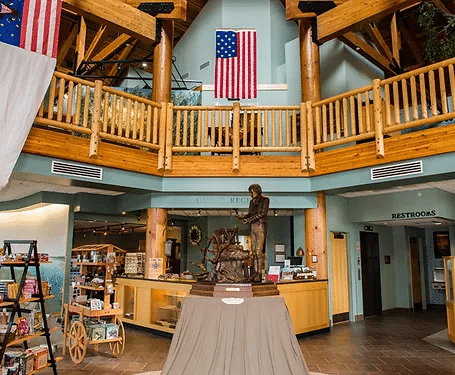
KANSAS
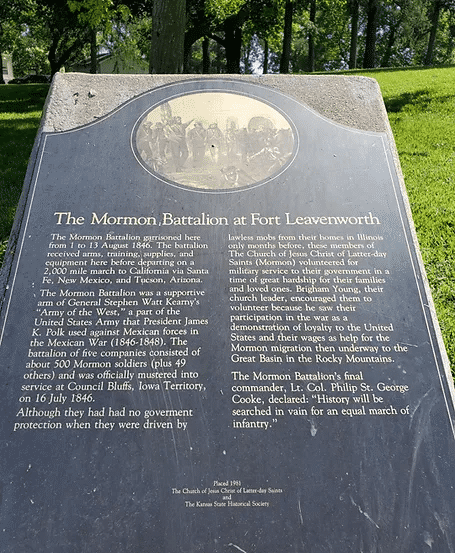
Leavenworth
The Battalion arrived at Fort Leavenworth on August 1, 1846. The post was established in 1827 and today is the oldest continually operating U.S. Army post west of the Mississippi River. The Frontier Army Museum at Fort Leavenworth features exhibits and displays of one of the best collections of 19th century military weapons and equipment. The Fort Leavenworth Wayside audio driving tour leads visitors to over 20 different historic, commemorative and scenic sites within the fort’s grounds including the inspiring Buffalo Soldier Monument memorializing the African American troops on the frontier. The Fort’s National Cemetery is one of the first 14 national cemeteries established by President Abraham Lincoln. The Leavenworth Landing Park Walking Trail in the downtown area features sculptures along the city’s scenic waterfront. Kids of all ages will enjoy the C.W. Parker Carousel Museum and Gift Shop. Leavenworth’s colorful history comes alive at the 1880s Victorian Carroll Mansion, First City Museum, and the Richard Allen Cultural Center and Museum. A variety of comfortable lodging is available. Go to this website.
Council Grove
Council Grove is on US 56. This city is named for the site of the 1825 treaty with the chiefs of the Great and Little Osage tribes making travel on the Santa Fe Trail possible. The Battalion rested and gathered forage from August 27 to 30, 1846, near the future site of the Kaw Mission. The town’s frontier history legacy can be discovered among 25 historic buildings and sites in the area, including the Kaw Mission State Historic Site. Visitors can take a self-guided tour or rent the Trail Trolley. The historic downtown features unique boutiques, galleries and restaurants. Lodging choices include motels, bed and breakfasts and campgrounds. Outdoor recreation options include the Federal Reservoir with six campgrounds, a marina and rental boats, the smaller Council Grove City Lake with boating and several public picnic areas, and the Council Grove Aquatic Center featuring a seasonal outdoor pool. The scenic Neosho Riverwalk connects the Neosho River crossing of the Santa Fe and Mormon Battalion Trails with the Kaw Mission State Historic Site and the Flint Hills Nature Trail State Park. Go to this website.
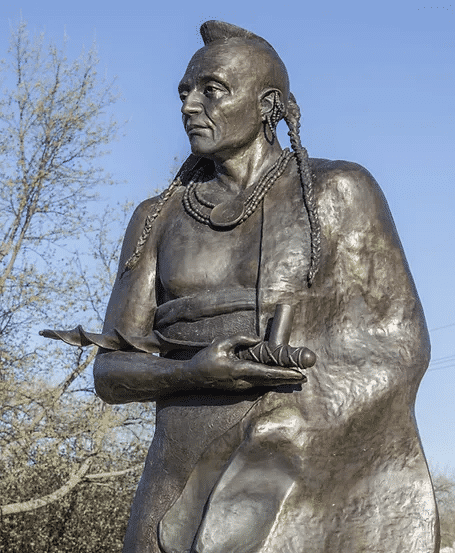
COLORADO
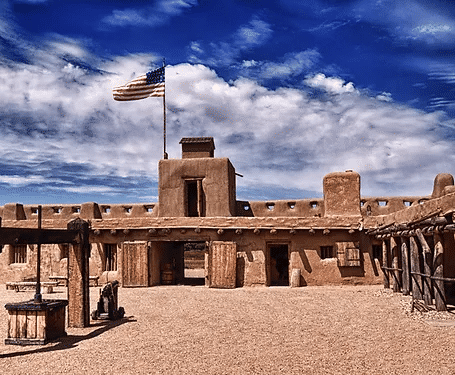
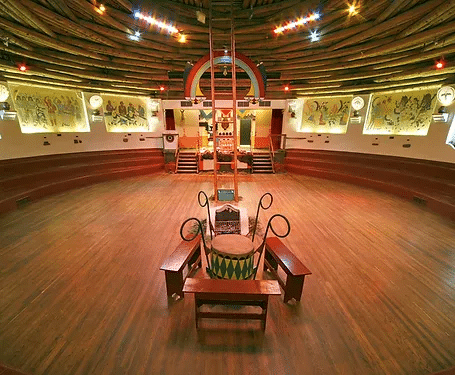
Bent’s Fort and La Junta
Bent’s Old Fort National Historic Site, CO – CO 194. The original Bent’s Fort was built in 1833-34 as a trading post where traders, trappers, travelers, and the Cheyenne and Arapaho tribes came together in peaceful terms for trade. The trading post became a military base in July 1846 during the War with Mexico by Brigadier General Stephan Kearny whose Army of the West preceded the Mormon Battalion to Santa Fe. It is assumed that the Higgins Group laid over at the fort from September 28 to 30, 1846. Today, the fort has been reconstructed by the National Park Service and is filled with period furnishings for visitors to get a feel for life at a frontier fort. Go to this website.
La Junta – US 50 and CO 109. The name La Junta means “the junction” in Spanish, and the original town was located at the junction of the Santa Fe Trail’s Mountain Branch and the Trappers’ Trail up to Colorado’s gold camps. The Koshare Museum features a Kiva replica with the largest self-supporting log roof in the world. Performances by the Koshare Dancers are showcased in the Kiva. The Koshare Museum houses a world-class collection of Native American art and artifacts. La Junta’s rich and varied history is on display at the Otero Museum. For outdoor enthusiasts, Comanche National Grassland features more than 400,000 acres of grass prairies, rugged canyons, over 300 species of wildlife, and prehistoric sea-beds with dinosaur tracks. Nearby Vogel Canyon is a great place for a short hike, a quiet picnic or a great spot to view the fall tarantula migration. Picketwire Canyon offers more of a strenuous hike with trails leading to Native American rock art, the ruins of an old Spanish mission, the remains of a 19th century ranch and the largest dinosaur tracksite in North America. Go to this website.
Pueblo
Pueblo, CO – I-25 and US 50. Early “El Pueblo” was initially built in 1842 as a cooperative base for traders, trappers and early settlers. On Christmas Eve 1854 a band of formerly friendly Utes attacked and killed most of the inhabitants. The Mormon Town Historic Marker is located where the Mormon Battalion’s family and sick detachments spent the winter of 1846-47 with the Mississippi Saints. The obelisk monument is located east of I-25 and BUS 50 on Stanton Avenue in a landscaped park. On one end of the Union Avenue Historic District, the El Pueblo History Museum features a recreated plaza with adobe buildings of the original El Pueblo. Visitors can see the excavated remains of the original El Pueblo in the adjacent Buckles Archaeology Pavilion. At the other end of the Union Avenue Historic District, the Pueblo Heritage Museum is devoted to the ethnic and cultural history of the people of Pueblo and includes artifacts and displays chronicling the area’s history. Visitors see vintage aircraft from World War 1 to Desert Storm at the Pueblo Weisbrod Aircraft Museum. The Arts come alive across Pueblo’s Creative Corridor which showcases art, music and dance with a variety of galleries, museums, street sculptures, fountains, cafes, live music and festivals. The Pueblo Zoo is a favorite family destination. For outdoor enthusiasts there is the City Park Disc Golf Course, the Pueblo River Trail System and Lake Pueblo State Park. Go to this website.
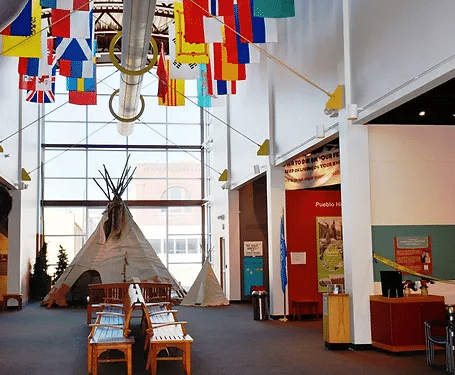
Odwiedź stronę 888starz-logowanie.com, aby poznać wszystkie szczegóły dotyczące logowania i oferty jednego z najlepszych kasyn online, które wspieramy.
NEW MEXICO

Santa Fe
Santa Fe, NM – I-25. Santa Fe was established as the capital for the Spanish “Kingdom of New Mexico” in 1610. U.S. Brigadier General Stephan Kearny, commander of the Army of the West, raised the American flag over the Plaza during the War with Mexico on August 18, 1846. The Mormon Battalion arrived October 9, 1846, and encamped on the northwest side of town, possibly near the Rosario chapel. Today the city is a mecca for art, culture, unique shopping and delicious New Mexican cuisine. Santa Fe Plaza features historic buildings including the Palace of Governors, the oldest continually occupied public building in the United States, as well as cultural gems like the New Mexico History Museum, the New Mexico Museum of Art, the Georgia O’Keeffe Museum, and great shopping, dining and local Native artisans within easy walking distance. Discovery Walking Tours of Santa Fe provides guides who can share insights on Santa Fe’s colorful history, cuisine and art. The Museum Hill area features the Museum of Indian Arts and Culture, the International Folk-Art Museum, the Wheelwright Museum of the American Indian and the Museum of Spanish Colonial Art. The Railyard and Guadalupe Districts feature contemporary art galleries and great restaurants in the setting of a 19th century railroad depot. Go to this website.
ARIZONA
Yuma
Yuma – I-8. The Mormon Battalion crossed the Colorado River southwest of Yuma on January 9-10, 1847. Today’s visitors can see a 10-foot-tall statue of Mormon Battalion officer Philemon Merrill to commemorate the Yuma Crossing at West Wetlands Park. Yuma’s unique Western heritage is on display at the Colorado River State Historic Park that once served as the US Army Quartermaster Depot from 1864 to 1883 for all southwestern military posts. The beautiful 10-acre park includes five buildings from the depot’s earliest days. The Yuma Territorial Prison State Historic Park is a fun stop for both western history buffs and ghost hunters. The prison has been featured in many Western movies. According to Guinness World Records, Yuma is the Sunniest City on Earth and the wide-open spaces around Yuma are great destinations for those seeking sunny, outdoor adventures. The Imperial Sand Dunes are popular with Instagram influencers and ATV off-roaders. Water adventures also abound in the area with kayaking, canoeing, tubing and boating on the Colorado River and area lakes. Visitors can also see the well preserved 1878 ghost town and mine with a day tour to Castle Dome Mine Museum. Go to this website.

CALIFORNIA
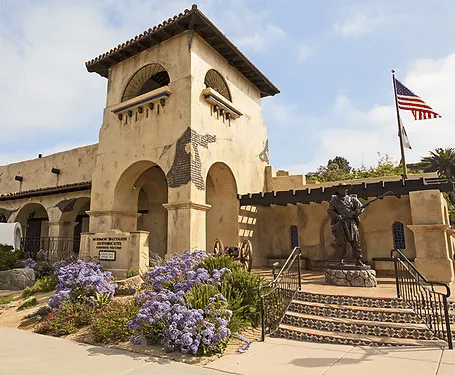
San Diego
San Diego – I-8 and I-5. The Mormon Battalion Historic Site at San Diego is adjacent to Old Town State Historic Park, south of Presidio Park and the I-8/I-5 interchange. Visitors may take a guided interactive video tour that highlights the faith, service and sacrifice of the Mormon Battalion volunteers during their 2,100-mile march from Council Bluffs, IA to San Diego, CA. Visitors can see historic artifacts, get a photo of themselves and their group in pioneer attire, and enjoy demonstrations of gold panning and brickmaking. Old Town San Diego State Park also includes other historical buildings and museums, restaurants, shops and galleries. Go to this website.
Los Angeles
Los Angeles – I-5, I-10 and I-15. The Mormon Battalion participated in California’s early development by building Fort Moore in Los Angeles which was dedicated on July 4, 1847. Today the Fort Moore Pioneer Memorial is at the site of the original Fort Moore at 451 N. Hill Street. The monument includes a waterfall and the largest bas-relief military monument in the U.S. The monument depicts Spanish ranchos, early California settlement, and the 2,100-mile march of the Mormon Battalion.
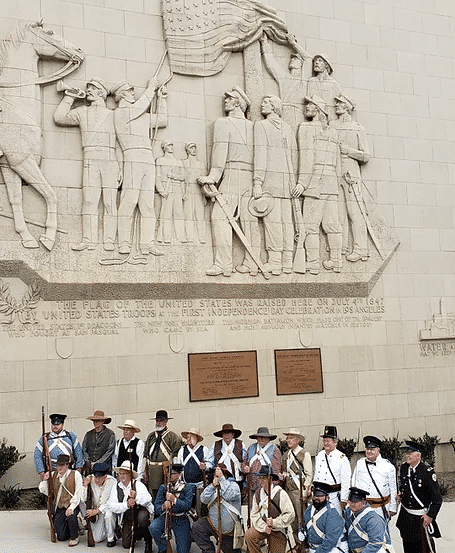
UTAH
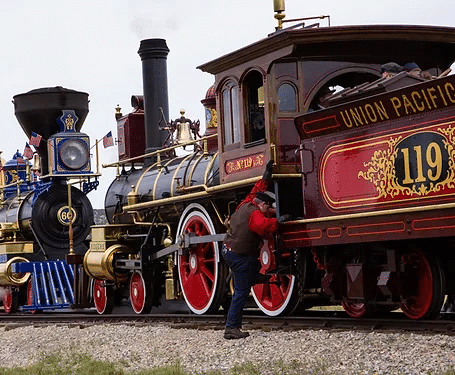
Ogden, Brigham City and Golden Spike
Ogden – North of Salt Lake City on I-15/84. Fort Buenaventura Park features the reconstructed fort and trading post built by mountain man Miles Goodyear in 1845. The park features a visitor center with artifact exhibits and a campground. Go to this website.
Brigham City – Off I-15/84. Mormon Pioneer Trail pioneer attractions include the Brigham City Museum-Gallery and the 1855 pioneer cabin near Box Elder Tabernacle and the Box Elder Museum. Go to this website.
Golden Spike National Historic Park – 32 miles west of I-15 at Exit 365 at UT 13 to UT 83. Follow the signs to SR 83 to the Golden Spike National Historic Park. This is the site of Promontory Summit where the “Golden Spike” was pounded in to complete the Nation’s first transcontinental railroad. Today the grounds include a visitor center, two operating steam engines and a walking trail. Go to this website.
Salt Lake City
Salt Lake City – I-80. The Great Salt Lake basin became the destination for Church of Jesus Christ of Latter-day Saint pioneers from 1847 – 1869. Brigham Young’s Vanguard group arrived at the south branch of City Creek and camped on the east side on July 23, 1847. This event is memorialized with a monument at Washington Square. The Mormon Battalion’s Pueblo group set their final camp on the grounds of today’s City Creek Center on July 29th. One of the first things they did upon their arrival was for Brigham Young to designate the location for a majestic, sacred Temple to their God. Today, Temple Square is undergoing renovation that is anticipated to be completed in 2024. During construction, visitors will be guided to the Conference Center. You can find more information at this website.
The nearby Tabernacle is home to the Tabernacle Choir at Temple Square and is one of the most acoustically sound buildings in the world. Families can trace their own ancestry at the Family History Library, while the Church History Museum features interactive exhibits that tell the history of the pioneers on the Mormon Trail. All of this is in the heart of Salt Lake City where visitors can find many opportunities for shopping, cultural events and every type of dining imaginable. Go to this website.
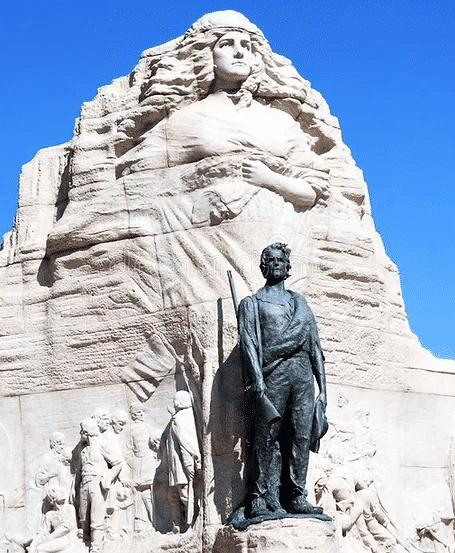
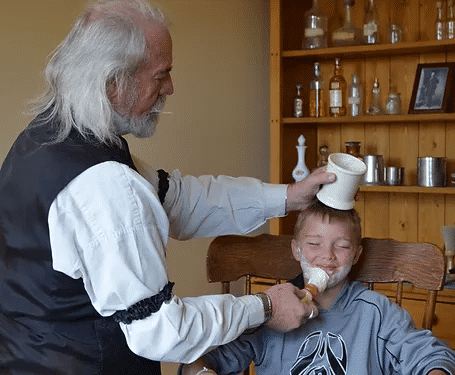
This Is The Place Heritage Park
This Is The Place Heritage Park – Immediately east of Salt Lake City on I-80 at the Foothill Drive Exit. The park includes the inspiring Duty Triumphs statue and monument dedicated to the Mormon Battalion. At This Is The Place Heritage Park, visitors can step back in time and experience the Old West and early pioneer life in Utah. This unique historical park is fun for everyone! Visitors can pan for gold, ride ponies, ride one of four trains for a tour around the park, make take-home crafts, interact with frontier shopkeepers, a blacksmith, tinsmith, and saddle maker and and see the Pioneer Children’s Memorial dedicated in 2021. Visitors can also see an early Native American Village featuring authentic Navajo Hagans, America’s largest teepee and Native American presentations of traditions, storytelling and much more before stopping at the best little Gift Shop west of the Mississippi. The park is also home to the National Pony Express Monument and Mormon Battalion Monument and Museum. This Is The Place Heritage Park is open from 9 AM to 5 PM Monday – Saturday. Visit the Gift Shop and Pioneer Center on Sunday. Go to this website.
Grantsville, Lehi and Provo/Utah Valley
Stansbury Park – Off I-80 on UT 138. The Ezra Taft Benson Grist Mill was built by Latter-day Saint pioneers in 1854 and is mentioned in pioneer diaries. Today the site includes the original gristmill, a sawmill, a re-created and operating gristmill, a country store, blacksmith shop, several historic cabins, barns, and picnic facilities. Go to this website.
Grantsville – on UT 138. The Grantsville Daughters of Utah Pioneer Museum at the Clark Historic Farm is open by appointment only. Call (435) 884-3767 or (435) 884-4311. The Donner-Reed Museum features a commemorative monument, wayside exhibits, an-1853 cabin, and a unique jail built in 1863. Open by appointment only, call Craig Anderson at (435) 884-3259.
Bluffdale – Southbound I-15 at Exit 288. A stone marker is at the location of Rockwell’s Station, once a Pony Express mail station, hotel and brewery operated by Orrin Porter Rockwell, often called “the Destroying Angel.”
Lehi – Located off I-15 at Exit 279. John Hutchins Museum of Natural History features exhibits on the Pony Express, the Church of Jesus Christ of Latter-Day Saints pioneers, and native peoples of the area. The Eagle Mountain Pony Express Trail Segment features pedestrian, bike, and equestrian trails, as well as wayside exhibits along the original Pony Express Trail. Go to this website.
Provo/Utah Valley – South of Salt Lake City on I-15. Provo is home to Brigham Young University which features the Museum of Art, the Covey Center for Fine Arts and the BYU Museum of Paleontology. Utah Valley includes the Uinta-Wasatch Cache National Forest, Robert Redford’s Sundance Resort, and the scenic Bridal Veil Falls. Go to this website
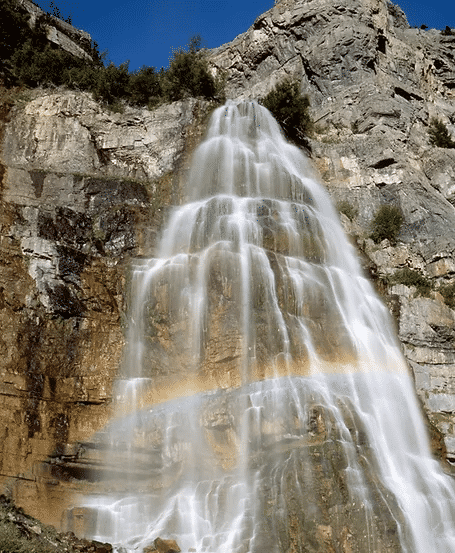
Special Thanks
The Mormon Battalion Association also wants to thank the following philanthropic organizations for their support of the Mormon Battalion 175th Anniversary Program:
– George S. and Delores Dore Eccles Foundation
– Sorenson Legacy Foundation
– Semnani Family Foundation
– The Church of Jesus Christ of Latter-day Saints
– Child Family Foundation
– Hullinger Family Foundation
– Uwe W. (Shaun) Michel
– Nebeker Family Foundation
Support the Cause
Looking to Support the Mormon Battalion Association in your own way? Click Below to find out how!
